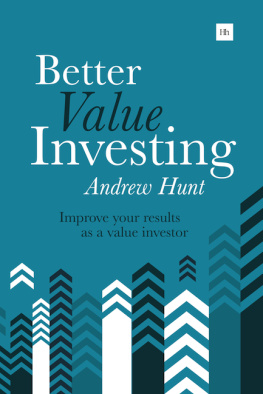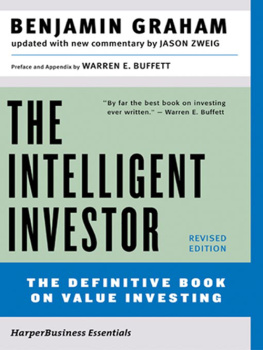Dutch investor Jeroen G. Bos has lived in England since 1978. He has a diploma in Economics from Sussex University and has worked his entire career in the financial services industry, mainly in the City of London. He worked for many years at stockbrokers Panmure Gordon & Co, and it was here that his interest in value investing developed. This process accelerated after the October 1987 stock market crash, during which time he took inspiration from The Intelligent Investor by Benjamin Graham.
At the end of 2003 Jeroen joined Church House Investment Management to manage CH Deep Value (Bahamas), which in March 2012 became the UK regulated Deep Value Investments Fund.
He lives in Sussex, is married and has three sons.
Jeroen Bos holds investments in the Deep Value Investments Fund, Norcon Plc and Record Plc.
FOREWORD BY MICHAEL VAN BIEMA
M ODERN FINANCE THEORY postulates a strong relationship between risk and return. Jeroen Bos and his investment style demonstrate the fallacy of this convenient but naive definition of the risk-return relationship. In this book, Jeroen explains how by being a deep value investor one weeds out investments that are both very low in risk and high in return
Jeroen practises a type of investing that I call Statue of Liberty investing to paraphrase: give us your poor, your forgotten, your unloved The companies he looks into have for the most part either been forgotten by most of the investment community or are actively shunned by them. Lurking, however, in the recesses of this netherworld of the investment universe one finds some equities that represent the ultimate in value. These are equities whose value is not justified by the future earnings envisioned by the fantasy of management or analysts, but rather by the current facts as presented in the companys balance sheets.
Effectively, what Jeroen teaches us in this book is how to read and think about balance sheets in a simple and very effective way. His goal is to uncover companies and therefore investments where the assets on the balance sheet outnumber the companys liabilities in such a way that the risk of investing in the companys equity is strongly mitigated, and, perhaps more importantly, can be accurately estimated relative to the potential return. The main focus of the book and of the 17 detailed investment examples it contains are so called net-net investments. These net-net investments were first described by Ben Graham who is widely considered the father of both value investing and, in fact, the field of security analysis. A net-net investment is equity where the current assets of the company outnumber all of the companys liabilities. As Graham put it, it is a way of buying a dollar for 50.
Jeroen began his value investing career as a broker in London where on his own he developed an attraction for both unloved securities and for 50 dollars. As he once told me, he had the ideal personality for this form of investing being both stubborn and cheap. Joking aside, there is truth to his statement in the sense that great value investors have to both have a nose for cheap securities and then have to be incredibly disciplined in purchasing them only when they are really at value prices.
Jeroen later became a broker to Peter Cundill, the legendary Canadian value investor who generated north of a 17% return annualized over the course of his 33 years career. Peter was a personal friend of mine as well and a member of the board of advisors of my firm. While a kind and generous man, Peter was not a man to suffer fools and his profitable dealings with Jeroen, especially with Amstrad, are a testament to Jeroens abilities to find investments of interest not just to mere mortals but to one of the super investors of the Graham school.
The book focuses on companies in the service sector since they are better able to rapidly adapt to changes in economic circumstance. Jeroen also stays away from companies that carry any significant amount of debt on their balance sheets, preferring instead to search for companies that are cash-rich.
The companies themselves span a broad cross-section of service industries, from a defense contractor to banking and currency exchange. Jeroen also describes some of his investments in retail and the difficulties associated with investing in that more fashion-driven sector. Some of the investments described here can only be described as legendary. A number are so called three-baggers, but even some of the more modest successes are legendary in the sense that one can buy equity in companies at such large discounts to their value, as Jeroen puts it in the case of Morson group: one could buy a profitable company with 500m in revenues for less than 20m.
The book is also complete in the sense that it provides a couple of examples of his mistakes and a few where the outcome is still uncertain. Perhaps the most instructive of this the Abbycrest case study, where Jeroen violates his own principle of staying away from companies with high levels of debt unfortunately with disastrous results. Two other cases that provide fascinating reading are those of Barratt Developments and Gleeson, both British homebuilders and both of which worked out extremely well, but both of which had quite different risks despite being in the same industry.
Another unique aspect of the book is Jeroens sell discipline. As he correctly points out, the types of investments he is looking for are not readily available in quantity. They are hard to find and frequently take a long time to develop. Unlike many value investors, he does not necessarily sell when his investments reach fair value; rather, he waits till some earning momentum develops and pushes the share price higher. He, therefore, unlike many value investors, leaves less on the table.
One of the beauties of this type of investing, as pointed out, is that it does not depend on earnings estimates and forward-looking statements by management. These tend to be, not surprisingly, less reliable and far more volatile than the balance sheet. In fact, since most investors depend heavily, if not entirely, on these types of estimates, income statement investors create the price volatility of which Jeroen and other balance sheet investors are able to take advantage.
It takes a few characteristics to be a great value investor. Some of the things we look for at our firm are:
a focus on the long term
a willingness to take a contrary view
patience
discipline.
As you read through this book, think about how Jeroen and the investment cases he describes display these characteristics. It will serve you well in your own investment career.
Michael van Biema
New York, 2013
Michael van Biema is the former Columbia University finance professor and founder and managing partner of funds of fund group van Biema Value Partners, LLC, based in New York. He is the co-author of the book Value Investing from Graham to Buffett and Beyond .
PREFACE
T HIS BOOK FOCUSES on a specific area of value investing, but it happens to be the area that has generated the biggest returns. Deep value investing is a defensive and high-potential strategy, picking out companies where it is very hard to lose money even in a worst-case scenario and where genuine potential means an almost unlimited upside when fortunes change. It is as simple as it is sophisticated. Above all, it is about standing apart from the crowd and letting the balance sheet do the talking.






